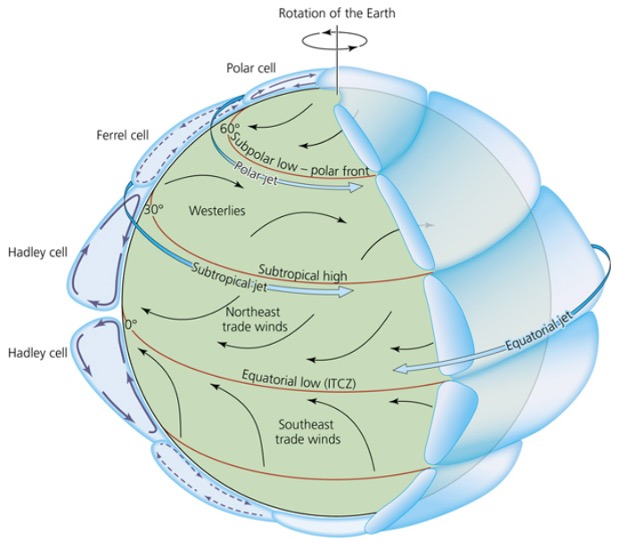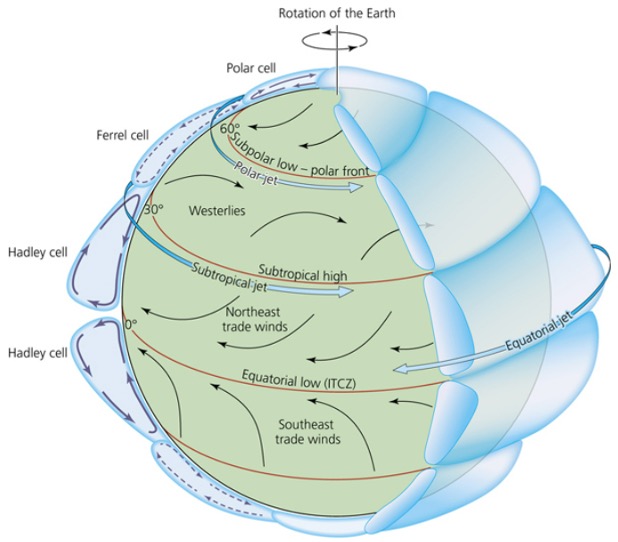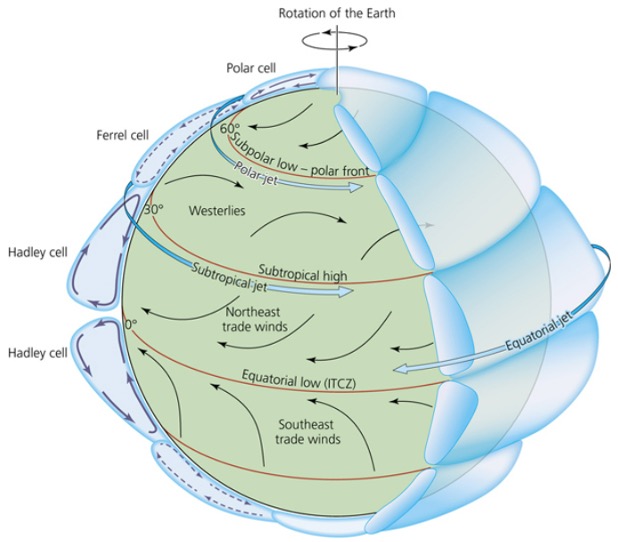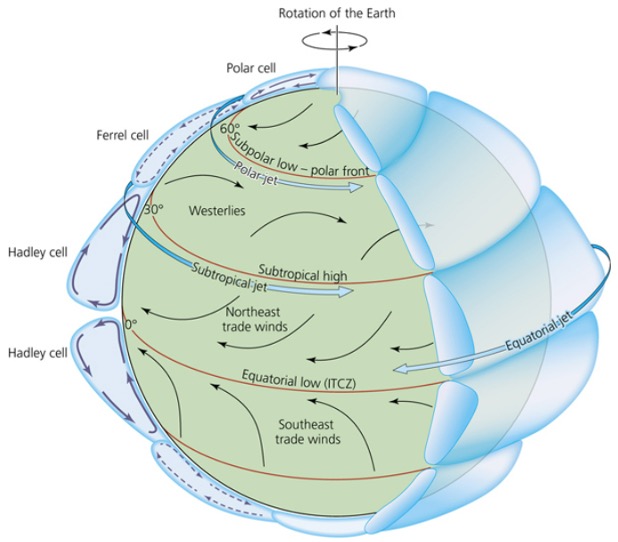GEOG101 Earth Sciences Exam 2
1/79
There's no tags or description
Looks like no tags are added yet.
Name | Mastery | Learn | Test | Matching | Spaced |
|---|
No study sessions yet.
80 Terms
Zonal Flow
Flows parallel to the line of latitude.
Meridonial Flow
Flows parallel to the line of longitude.

Equatorial Low
0 deg, ITCZ (intertropical convergence zone)
low pressure
in the Hadley Cell (rising air)
converging Northeast Trade Winds & Southeast Trade Winds

Subtropical High
30 deg
high pressure
the boundary between the Hadley Cell (sinking air) and the Ferrel Cell (starting point)
towards the equator → Trade Winds (E → W) (0 - 30 deg lat)
towards the poles → Westerlies (W → E) (30 - 60 deg lat)

Subpolar Low
60 deg
low pressure
the boundary between the Ferrel Cell (rising air) and the Polar Cell (starting point)
convergence of Westerlies & Polar Easterlies (E → W) (60 deg - 90 deg lat)

Polar High
90 deg
high pressure
in the Polar Cell (sinking air)
Outflow (transfer from the) Polar Easterlies
What are the major jet streams?
Polar and Subtropical Jets
Cold air is (more/less) dense.
More dense
The atmospheric pressure decreases more quickly with height
Warm air is (more/less) dense.
Less dense
Pressure does not decrease as rapidly with height
Flows above the cold air
Pressure Gradient Force
A net force resulting from high to low pressure
responsible for triggering the initial movement of air
stronger the temp. gradient, stronger the jet
The Coriolis Effect causes the direction of air in the Northern Hemisphere to the ____.
Right
The Coriolis Effect causes the direction of air in the Southern Hemisphere to the ____.
Left
Air in the Northern Hemisphere flows from ___ to _____.
South; North
ITCZ (Intertropical Convergence Zone)
Key part of the Hadley Cell and circulation system
Belt of low pressure located near the equator around 0 deg lat.
Forms where the Northeast Trade Winds (from Northern Hem.) and the Southeast Trade Winds (from Southern Hem.) converge
Why does the ITCZ form?
The equator recieves the most direct solar heating —> hot, moist air rises
rising air creates a Low Pressure Zone (Equatorial Low)
as the air rises, it cools → condensation → heavy rainfall & thunderstorms
Mixed Ocean Layer (0-75 m / 245 ft)
Characteristics
top layer of the ocean
makes up only about 3% of ocean volume
temperature and salinity are relatively constant
Why it’s like this
sunlight warms the surface, and wind/storms cause mixing, distributing heat and salt evenly
due to this mixing, there’s little temperature change in this layer
Thermocline Ocean Layer (75 - 1000 m / 245 - 3300 ft)
Characteristics
temperature drops rapidly with depth
acts as a transition between warm surface waters and cold deep waters
Why it’s like this
sunlight does not reach deeply, so water gets colder as you go down
there is less mixing here than in the surface layer, so the temperature change is sharper
this layer separates the warm mixed layer from the cold deep ocean
Deep Ocean Layer (1000 m+ / 3300 ft+)
Characteristics
makes up 97% of ocean volume
temperature is very cold and constant (around 2-4 deg C)
Why it’s like this
sunlight cannot penetrate so there’s no direct heating
water is densely packed and very stable so it doesn’t mix much vertically
this layer is mostly fed by cold, dense water sinking near the poles
Wind generates ocean currents through…
Kinetic energy and the Coriolis Effect after motion starts
Sea water density generates ocean currents through…
Temperature and salinity differences
Gyres
Large, circular ocean current systems driven by winds and the Coriolis effect that redistributes heat across the planet
How do prevailing winds influence ocean currents?
They push surface water, setting ocean gyres and currents into motion.
What role does the Coriolis force play in ocean circulation?
It causes currents to curve (right in the Norhtern Hemisphere and left in the Southern) helping form gyres.
How do land masses affect ocean gyres?
They block and redirect ocean currents, causing them to circulate in loops rather than flow straight across the ocean.
What are tropical gyres and what drives them?
Warm-water gyres near the equator driven mainly by trade winds.
What characterizes subtropical gyres?
Large, warm-water gyres between 20 deg - 40 deg latitude driven by trade winds and westerlies.
What is upwellling and why is it important?
The upward movement of cold, nutrient-rich water to the surface, supporting marine ecosystems and high productivity.
Ekman Transport
The net movement of surface water caused by wind and the Coriolis Effect.
when wind blows over the ocean, it pushes the surface water
due to the Coriolis Effect, water moves at an angle (to the right of the Northern Hemisphere, to the left of the Southern Hemisphere)
each layer of water drags the one below it, creating a spiral of movement known as the Ekman spiral
the overall (net) transportation of water ends up being 90 deg to the right of the wind direction in the Northern Hemisphere and 90 deg to the left in the Southern Hemisphere
What is the main difference between wind-driven flow and deep ocean currents?
Wind-driven flow moves surface water with winds, while deep ocean currents are driven by density differences caused by temperature and salinity.
What drives thermohaline circulation?
Differences in water density caused by variations in temperature and salinity.
What is the Global Conveyor Belt?
The global system of deep and surface ocean currents driven by thermohaline circulation that redistributes heat, nutrients, and gases around the world.
Why is water’s latent heat of fusion important?
It absorbs a lot of energy during melting, helping regulate temperature and climate stability.
What does a high latent heat of vaporization allow water to do?
Lets water store and transfer large amounts of heat energy, influencing weather and cooling processes.
Why is condensation important to Earth’s energy balance?
Releases heat into the atmosphere, fueling storms and redistributing energy.
What happens during sublimation?
Ice absorbs energy and turns directly into vapor, transferring heat without melting first.
What is deposition and what happens to energy during it?
Gas changes directly to solid, releasing energy to the surroundings.
What is vapor pressure?
The pressure exerted by water vapor molecules in the air; increases as more water vapor is present.
What does the dew-point temperature tell us?
It’s the temperature at which air becomes saturated and condensation begins.
What is specific humidity?
The ratio of the mass of water vapor to the total mass of air, measured in g/kg.
What does relative humidity measure?
The amount of water vapor in the air expressed as a % of the maximum the air could hold at that temperature.
What is the main energy source for evaporation?
Heat energy, primarily from shortwave solar radiation, with some contribution from longwave radiation and horizontal advection.
Why does evaporation require unsaturated air?
Because the air must be able to hold more water vapor. A strong vapor pressure gradient increases evaporation.
What is atmospheric demand?
The ability of the atmosphere to take up water vapor, influenced by temperature, humidity, and wind.
What is the first requirement for precipitation?
The presence of clouds, which form when air becomes saturated and condensation occurs.
What does it mean for air to be saturated?
The air contains the maximum amount of water vapor it can hold at a given temperature.
What are two main ways air can reach saturation?
By cooling to the dew point or by adding more moisture to the air.
What are condensation nuclei and why are they important?
Tiny particles like dust or salt that water vapor condenses onto; they’re necessary for cloud formation.
Stratus clouds
Layered, gray clouds that cover large portions of the sky, often bringing light rain or drizzle.
Cumulus clouds
Puffy, cotton-like clouds that can grow vertically into large storm clouds.
Cirrus clouds
Thin, wispy, high-altittude clouds made of ice crystals, often signaling changing weather.
What type of weather is associated with nimbostratus clouds?
Steady, continuous rain or snow without thunder or lightning.
What does the name “nimbostratus” mean?
“Rain layer”
nimbus (rain)
stratus (layer)
What type of cloud produces thunderstorms and severe weather?
Cumulonimbus clouds
Cumulonimbus clouds
Towering, anvil-shaped clouds that can extend through all levels of the troposphere.
What does the name “cumulonimbus” mean?
Rain heap
cumulus (heap)
nimbus (rain)
What are the four main lifting mechanisms that produce precipitation?
Convergent lifting, frontal lifting, convectional lifting, and orographic lifting.
What happens during convergent lifting?
Air flows from different directions, meets, and is forced upward, leading to clouds and rain.
What is frontal lifting?
When warm air is forced to rise over cold air where two air masses meet.
What type of weather is caused by convectional lifting?
Afternoon thunderstorms or short, intense rain showers from rising heated air.
What is orographic lifting?
When air rises over mountains, cooling and forming precipitation on the windward side.
What is the rain shadow effect?
The dry area on the leeward side of a mountain due to descending, warm air.
Which lifting mechanism is most common near the equator?
Convergent lifting (due to ITCZ).
What latitudes are considered low latittudes for weather systems?
Between 0 deg and 25 deg north or south of the equator
What are easterly waves?
Westward-moving low pressure disturbances in tropical easterly winds that can develop into tropical storms.
Where do easterly waves occur most often?
Between about 5 deg - 30 deg latitude north and south of the equator
What is a tropical depression?
A weak, low pressure system with organized rotation and sustained winds below 39 mph.
What marks the transition from a tropical depression to a tropical storm?
When sustained wind speeds reach 39-73 mph and the storm becomes more organized.
When does a tropical storm become a hurricane or tropical cyclone?
When sustained wind speeds reach at least 74 mph (119 km/h)
What part of a tropical cyclone has the highest wind speeds?
The eyewall
What provides energy for tropical cyclones?
Warm ocean water and the latent heat released during condensation.
What are the regional names for tropical cyclones?
Hurricanes (Atlantic/Northeast Pacific)
Typhoons (Northwest Pacific)
Cyclones (Indian Ocean/South Pacific)
At what latitudes do tropical cyclones form?
Between 0 deg - 30 deg north or south of the equator.
What fuels tropical cyclones?
Warm, moist ocean air providing heat and energy through condensation
What part of a tropical cyclone has the strongest winds?
The eyewall
What is a storm surge?
A rise in sea level caused by hurricane winds and low pressure, leading to coastal flooding
What latitudes experience stronger temperature contrasts between air masses?
Mid and high latitudes (do deg - 90 deg)
What is a polar jet stream?
A fast-flowing band of air that forms where warm tropical and cold polar air meet and steers storms
What is cyclogenesis?
The process of forming and developing mid-latitude cyclones
What is a mature mid-latitude cyclone?
A large rotating system with warm and cold fronts producing widespread rain and storms.
What drives the formation of mid-latitude cyclones?
Strong temperature gradients and the polar jet stream